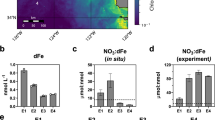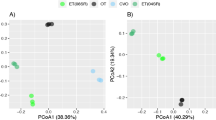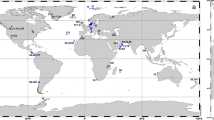Abstract
Arising from Cardinale, B. J. Nature 472, 86–89 (2011)10.1038/nature09904
The influence of biodiversity on ecosystem function has been of interest to community ecologists for decades. Recently, Cardinale1 reported that biodiversity affects nitrate (NO3−) uptake in algal communities and that, as a result, biodiversity may help mitigate nutrient pollution. Although Cardinale’s conclusions about niche partitioning are interesting (figure 2 in ref. 1), his extension of these findings to problems of nutrient pollution is premature. Algal uptake is only a short-term nitrogen sink; control of NO3− pollution requires long-term solutions.
Similar content being viewed by others
Main
Nitrate removal in streams typically occurs via two pathways. Denitrification is the microbial conversion of NO3− to N2 gas (Fig. 1). This is the most important means of permanent NO3− removal from streams. However, it is not considered in Cardinale’s study.
Red arrows indicate processes not measured by Cardinale1. Storage in groundwater and sediments, N2 fixation and fluxes to other ecosystems (for example, floodplains) may also occur.
The second NO3− uptake pathway is assimilation by primary producers (in this case, algae). Algae acquire nutrients to fulfil physiological demands and support growth, but these same nutrients are later released after cell death or disruption (such as the brushing treatment applied to some flumes to create heterogeneity). Algal uptake leads to temporary storage of nitrogen in algal tissues (turnover time ranges from ∼17.5–47 days2,3,4), and can have significant short-term effects on nitrogen export to downstream ecosystems. But, because benthic algae do not accumulate over long (annual or interannual) periods, this uptake mechanism represents only a transient storage pool and thus has no enduring effect on downstream water quality (Fig. 1).
Algae could potentially mediate permanent nitrogen removal in streams by facilitating increased rates of denitrification5,6. Indeed, Cardinale’s results raise the intriguing possibility that algal diversity could affect denitrification rates via changes in the availability of nitrogen, carbon or oxygen to denitrifiers. However, until this potential effect is demonstrated, conclusions about biodiversity effects on the control of aquatic nitrogen pollution are premature.
We agree with Cardinale that nitrogen enrichment threatens the integrity of aquatic ecosystems and that nitrogen removal is a critical ecosystem service provided by streams7. And, although Cardinale has elucidated a potential mechanism for biodiversity to influence stream nutrient cycling, for this work to be extended to pollution control in natural ecosystems it must be tested in environments incorporating critical biogeochemical pathways—namely, denitrification and nitrogen fixation—and it must consider long-term nitrogen dynamics.
References
Cardinale, B. J. Biodiversity improves water quality through niche partitioning. Nature 472, 86–89 (2011)
Merriam, J. L. et al. Characterizing nitrogen dynamics, retention and transport in a tropical rainforest stream using an in situ15N addition. Freshw. Biol. 47, 143–160 (2002)
Mulholland, P. J. et al. Nitrogen cycling in a forest stream determined by a 15N tracer addition. Ecol. Monogr. 70, 471–493 (2000)
Tank, J. L. et al. Analysis of nitrogen cycling in a forest stream during autumn using a 15N-tracer addition. Limnol. Oceanogr. 45, 1013–1029 (2000)
Ishida, C. K., Arnon, S., Peterson, C. G., Kelly, J. J. & Gray, K. A. Influence of algal community structure on denitrification rates in periphyton cultivated on artificial substrata. Microb. Ecol. 56, 140–152 (2008)
McMillan, S. K., Piehler, M. F., Thompson, S. P. & Paerl, H. W. Denitrification of nitrogen released from senescing algal biomass in coastal agricultural headwater streams. J. Environ. Qual. 39, 274–281 (2010)
Mulholland, P. J. et al. Stream denitrification across biomes and its response to anthropogenic nitrate loading. Nature 452, 202–205 (2008)
Author information
Authors and Affiliations
Contributions
All authors contributed to writing and revising this paper.
Corresponding author
Ethics declarations
Competing interests
Competing financial interests: declared none.
PowerPoint slides
Rights and permissions
About this article
Cite this article
Baulch, H., Stanley, E. & Bernhardt, E. Can algal uptake stop NO3− pollution?. Nature 477, E3 (2011). https://doi.org/10.1038/nature10418
Published:
Issue Date:
DOI: https://doi.org/10.1038/nature10418
This article is cited by
-
Cardinale reply
Nature (2011)
Comments
By submitting a comment you agree to abide by our Terms and Community Guidelines. If you find something abusive or that does not comply with our terms or guidelines please flag it as inappropriate.




